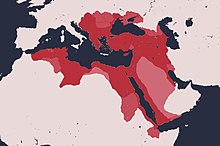Indo-Mediterranean
[3] Caravan traffic through the extended arid zone at the heart of much of Afro-Eurasia played a significant role in allowing for Indian Ocean and Mediterranean ports to thrive and trade with each other.
The Achaemenid Empire established dominance over territories throughout the Middle East by the fourth century BCE, creating new possibilities for interaction across Eurasia and its southern maritime spaces.
[6] It was then overtaken by Alexander the Great's eastward conquests in that century which resulted in an expansion of the Hellenistic world to northwest India; this helped link the Indian Ocean trade to the Eastern Mediterranean.
Islam's success in connecting land and maritime spaces throughout Afro-Eurasia, contrasting with certain anti-maritime attitudes such as kala pani that could be found in the Indian Ocean and Mediterranean from the pre-medieval era,[20] can be seen in the 14th century voyages of the famous traveller Ibn Battuta.
For the Ottomans, their conquest of Constantinople in 1453 increased their reach in the Mediterranean, and in the next century, they also gained access to the western Indian Ocean by acquiring Egypt and Baghdad.
[27] In general, the Western European presence in the Indian Ocean was based on precedents formed in the Mediterranean by Venice and Genoa, bringing gun-based "trading-post empires" to a previously peaceful region.
[32] The 1869 completion of the Suez Canal then helped to greatly expand European colonialism, as it enabled faster passage from Europe to Indian Ocean Afro-Asia.
Indian External Affairs Minister S. Jaishankar affirmed the initiative in 2024, citing the historical importance and rising trade taking place in the region.






